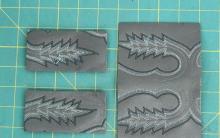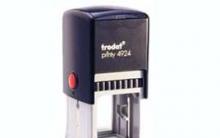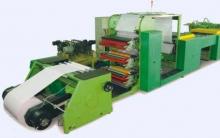Book printing. Making simple and complex notebooks
From the invention of the printing press by Johannes Gutenberg in the 15th century until the end of the 19th century, the technology of printing and binding processes changed little. In the 20th century, with the advent and development of new technologies, the process of printing books was increasingly expanded and automated, and now consists of more than 70 operations. Their composition depends on various factors: the level of printing design, volume, requirements for the durability of the publication. Making book notebooks is one of the most important stages in the printing process. Drawing up a book block not from separate sheets, but from notebooks, is not at all a tribute to the traditions of ancient printing, but a technological necessity. It is this type of block that provides the book with good durability and strength at low labor intensity of binding processes.
Features of printing books consisting of simple notebooks
Simple notebooks are made up of 8 (16, 32) pages, which are obtained with two-, three-, four-fold perpendicular symmetrical folding. The process of their manufacture consists of several stages: colliding sheets, trimming and cutting them into pieces, followed by folding and pressing.
In the process of colliding, the edges of the sheet materials are aligned. It can be done both manually and on special colliding machines. After this operation, the sheets are counted and stacked for further processing.
If books are printed on a sheet of 1000x1400 mm format, then 64 pages of a book of 70x100 / 16 format are placed on it. In order to get notebooks with a volume of eight, sixteen, thirty-two pages, the sheets must be cut into eight, four, two parts, respectively. Sometimes, before cutting sheets, it is necessary to trim them, i.e. remove registration marks and control scales from the edges. Trimming and cutting operations are carried out using single-knife paper-cutting machines. It happens that illustrations-inserts are inserted into the book block of an out-of-print book.
In the manufacture of simple notebooks, folding options can be one-, two-, three-, four-fold. The folding operation can be performed manually in small printers that print books in short runs, as well as on automatic folding machines in large printing companies. After this operation, the book block processing for printing large size books is performed.
In order to fix the deformation in those places where the bend occurred during the folding process, the notebooks are pressed in special packing and crimping presses. This operation also achieves equalization of the thickness of the book blocks, which may differ due to variations in paper thickness. At the next stages of book printing, the book block is connected to the cover using endpapers.
Making complex notebooks when printing books
Unlike simple notebooks, which are eight, sixteen, or thirty-two pages long, complex notebooks consist of four, twelve, or twenty-four pages, or have additional design elements, such as endpapers or insert illustrations. The process of their manufacture is more complex, requiring more time and strict adherence to technological processes.
Endpapers are made of special endpaper, which differs from the usual higher strength. In mini-printing houses, endpapers are glued manually with starch glue, and in large ones, with quick-setting PVAD glue on endpaper-gluing machines at a speed of 100 pcs/min.
Insert illustrations are always printed separately from the text, as a rule, with colored inks and on higher quality paper, and then glued to the notebook, most often to its first or last page, sometimes in the middle of the notebook.
Of course, those who want to start their own production of notebooks will not become the pioneers of this business, however, it will be quite easy for them to succeed. Not a single person can be imagined without a notebook, notebook or other stationery manufactured products, regardless of whether it is a housewife or a schoolboy, an elderly person or a young man. They are in every briefcase, backpack or purse. That is why such a business as the production of notebooks in Russia is in demand.
Start of activity
To begin with, an entrepreneur needs to conclude a long-term contract with a paper recycling company.
Thus, he will get rid of problems with the supply of raw materials for his notebook production, which is important in the conditions of great competition in the stationery market.
Not only the future turnover, but also the expected profit depends on this. The larger the range of notebooks, the more customers or buyers will buy from a particular manufacturer, which means that the income from the business will increase.
It is not so difficult to organize the production of school notebooks or notebooks, although, of course, it is impossible to carry it out at home. To work, you will need special equipment that works with computer precision.
Market features
The production of notebooks, according to experts, is a very profitable business. After all, notebooks, regardless of the number of sheets, are always in great demand. They are sold constantly, besides, they are most actively bought up on the eve of the opening of the school season.
At the same time, buyers very rarely remember the name of the trademark, in addition, they are not demanding on brands in this area. For them, the main thing is price, design and quality. Therefore, in order to increase the level of sales of their products, many manufacturers are trying by any means to attract consumers to it, offering them not only exclusive products, but also new collections.
In the process of designing notebooks, it is imperative to take into account a fairly large number of different nuances. It is necessary to take into account not only the age category or preferences of small buyers, but also their social status. It is very important to choose the right time to start releasing licensed products when the popularity of a particular series becomes unusually high, or, for example, the premiere of a sensational cartoon or film is scheduled in the coming days.
At the same time, even the most experienced marketers cannot be one hundred percent sure that the production of notebooks featuring these beloved characters (second edition) will be in the same demand as the first edition. At the same time, according to the leaders of large companies producing stationery, it is necessary to change the collection at least once a year, although some players in this market update them two or three times during each new season.
Notebook production technology

Production includes only two stages. First, notebook sheets are printed in accordance with design layouts and folded. The second step is to bond them. With the help of staples, notebooks with a small number of pages are obtained.
Whereas with their large volume, the connection is carried out by both brackets and springs. When creating covers, printing technology is used with ultraviolet inks, which make it possible to use the entire palette of colors. This makes them even more attractive. In addition, the production of notebooks sometimes involves the use of continuous or selective varnishing technologies, as well as surface embossing.
Licensing Issues
To place pictures from cartoons on the cover of a notebook, the owner of a printing organization must obtain permission from the cartoon company or purchase a license from it. You can pay for the license immediately, or you can take it as a pledge.
I must say that many small private enterprises that do business on schoolchildren do not even think about it, placing any photo or character on their products. These small firms use other people's images illegally because they don't want to pay large enough fees for a license. However, although this is practiced everywhere, such an approach is fraught with a number of troubles, and first of all - problems with the tax inspectorate.
Notebooks with photos of young idols, cartoon characters or characters from TV shows on the cover are a little more expensive than regular ones. And this is not surprising, since their price also includes the cost of a license, reaching up to several thousand dollars. Usually a license is bought for several years. However, in most cases the actual use times are much shorter as the preferences or tastes of children and young people change quite quickly.
Equipment
Like any production, the production of notebooks also involves the availability of machine tools and other equipment. To begin with, of course, you need to rent or buy an appropriate room where they can be placed. The equipment for the production of notebooks is as follows: a crimping press, a wire stitching and sheet cutting machine, a three-knife paper cutting machine, it is considered optimal to have at least two copies of it, a punching and creasing machine, a folding machine and foil stamping units. In addition, in some cases, printing devices may also be needed, for which special rollers will need to be purchased.

Peculiarities
You can, of course, saving up to half the cost, buy used machines sold by the same enterprises, but most of this equipment, already in use, is already obsolete for a long time. In addition, many of the machines on which these printing companies worked were purchased in the middle of the last century, and their wear and tear today may be too great.
It should also be borne in mind that the production of such stationery is considered harmful, so all purchased equipment must be accompanied by appropriate certificates confirming their safety for people and the environment.
Costs and payback
 In order to organize the production of notebooks, a workshop will require a room with an area of a thousand square meters in order to place equipment in it.
In order to organize the production of notebooks, a workshop will require a room with an area of a thousand square meters in order to place equipment in it.
In addition, administrative spaces will also be needed, as well as warehouses to store raw materials and finished products.
The total number of employees in such an enterprise is, on average, fifty people, most of whom work in production.
The business plan of a printing company with an average productivity will require more than ten million rubles in expenses. The average payback period for such a project will be at least three years.
The total cost of all the required equipment will be from five million rubles, and if the calculations are carried out based on the cost of Russian-made machine tools with a fairly high performance. At the same time, you can order from domestic machine-building plants or purchase new equipment abroad, which will cost much more.
Additional profit
The production of notebooks can be expanded by the production of notebooks. They can be as diverse as possible, cheap and expensive, designed for every taste of the buyer. In general, stationery will always be in demand, so this business is almost one hundred percent successful. However, having decided to engage in this type of production, an entrepreneur must necessarily draw up a business plan that will help him avoid many mistakes.
Competition in the school notebook market
Domestic companies occupy the leading place in the market of notebooks. Of the foreign manufacturers of this paper and white products, Ukrainian enterprises are best represented. However, according to analysts, the capacity of Russian enterprises is sufficient to satisfy the existing demand for these products. In general, Russian products are presented in various price segments and are of very high quality, not inferior to imported notebooks. For the production of both those and others, the same machines and consumables are used, allowing you to create different effects on the covers (glitters, varnishes, etc.). At the same time, Russian-made paper also has good characteristics. For these reasons, the share of foreign manufacturers in the domestic market is small. Their products cannot compete with notebooks of a similar price category in terms of price due to the cost of transportation, customs clearance, etc., and parents buy more expensive paper and white products much less often, because a lot of notebooks will be required during the child’s schooling, and in these extra spending is pointless. Therefore, foreign manufacturers have relied on the segment of office products, not school products. Of course, there is competition in the notebook market, but among domestic companies. It manifests itself most clearly in the segment of common notebooks, which is already quite saturated. Among the players here are both large federal companies operating throughout the country, as well as small regional ones. The high level of competition has its advantages. Companies are constantly fighting for the quality of their products, expanding their range and even acquiring licenses for the production of products with famous idols of youth, heroes of TV shows and cartoons. The larger the company, the greater the circulation of its products. Such enterprises can afford to purchase expensive equipment: machines for applying various special effects, for multi-color printing of covers, and high-quality rulers. Small companies prefer to work in a certain segment for one or more regions. They cannot compete with the giants in terms of quality and variety, but they are able to set lower prices for their products.
It is believed that the production of school notebooks is highly profitable, but in fact this is not entirely true. The cost of the notebook is really low, as is the retail margin. But the organization of the sale of finished products requires considerable investments - at least 30-40% of the cost of the notebook itself. Small factories cannot "take" volume, so to increase their profits, they turn to producing other types of products with the possibility of a higher margin. These include, for example, the production of envelopes, business diaries, notepads, office paper, etc. At the same time, as experts say, the market for white paper products is very volatile, and the situation on it is difficult to predict. Companies that have existed in our country since Russian times have gradually realized the need to upgrade equipment, expand and adjust to consumer needs. They finally have marketers on their staff who research the opinions of the public and try to take them into account when compiling the assortment. These large enterprises with a rich history, as well as leading book publishing companies, are still leading the market for notebooks. Among the main manufacturers are: APPM (the undisputed leader), BG, Hatber, KantsEksmo, Polygraphics, PZBF, Voskhod, AST, Akademiya Holding, KTS-pro, etc.
The interest of new participants (including book publishers) in this segment is understandable. It is difficult to find another product that is equally "convenient" in the production and sale. School notebooks have a limited lifespan. They are often changed several times a year. They are not subject to strict requirements. The main criteria for choosing a notebook, as surveys show: price and appearance (design). Although buyers still pay attention to the quality of products. For elementary school students, for example, the paper on which they write is of great importance. It should be perfectly white, fairly dense and have a smooth surface. Although the notebook itself has a very short lifespan, but its manufacturers are trying to make their products more durable. After all, often notebooks are stored for more than one year even after use. The generally accepted standards that manufacturers adhere to in the manufacture of the indoor unit are as follows: paper weight 65-80gsm. m, smooth ruler, clear margins, whiteness 92-95%.
The target audience
The main consumers of such products are schoolchildren aged 6.5-7 to 18 years. Therefore, it is not surprising that the demand for notebooks largely depends on the demographic situation in the country. For example, during the demographic decline, the production of thin notebooks decreased by more than 4%, while the production of general ones, on the contrary, increased by almost 6%. Since the beginning of the 2000s, there has been an increase in the total birth rate, so the number of target audience for paper products has also increased. When determining the range of produced notebooks, it is very important to choose the right cover designs. They directly depend on the age of the target audience. So, for example, designs with images of animals and cartoon characters, modern cars and robots are created for younger students. The brighter and more colorful the picture, the better. On the other hand, it should be borne in mind that many teachers strongly recommend that parents of their students purchase thin notebooks (12-18 sheets) without multi-colored drawings on the covers, which, according to teachers, distract kids from learning. Therefore, your assortment should also include notebooks with plain covers (not necessarily the traditional green color). Middle and high school students prefer notebooks depicting heroes of popular TV shows, movie actors or musical performers. In addition, notebooks with more strict covers are in no less demand among older children. Students choose notebooks with a business style design.
Notebooks can hardly be called a super-profitable product, but, first of all, this applies to products up to 48 sheets with a one-color cover (the most budget option). According to the players of this market, prices for cheap products are too low today. The reason for this lies in the policy of large wholesale companies that make high markups on cheap goods, leaving no chance for retail companies to make money on their sale. In turn, such a low cost policy for notebooks is explained by fierce competition and the desire of sellers to attract customers by any means. But the production of common notebooks with bright covers, on the contrary, is considered profitable. After all, the main target audience of such products is consumers with an average income level (of whom the majority in our country). In addition, these notebooks are purchased less often, designed for a longer service life, so buyers are willing to pay more for them.
Production of notebooks
The manufacture of simple book notebooks from prints that are obtained on sheet-fed printing machines includes several stages at once: colliding, trimming, cutting sheets into pieces, folding, pressing, binding notebooks, and storing them. For the production of notebooks, the raw material comes in the form of pressed cellulose, which is then mixed with water and various chemicals and fed into a special unit that turns the liquid mass into sheets of paper. In another workshop, the resulting paper is lined, after which it is cut into separate sheets. Colliding of sheets of paper is carried out manually, on colliding semi-automatic machines and on automated lines. The first option is too heavy and expensive, so it is practically not used today. At some small printing enterprises, simple and inexpensive collating machines are used for colliding. Such a machine is equipped with a massive base, has a table with two low supporting walls, a sheet blowing system and an electric drive that ensures the table vibrates during the collision process. A stack of sheets of future notebooks is aligned against the side walls of such a machine. Most modern printing companies use automated integrated systems that perform the entire range of operations - from colliding to cutting. After colliding, sheets of paper and prints are counted and stacked in stacks of 500 copies on pallets in stacks. In this case, each stack is separated from the other by strips of colored paper. In its design, a notebook is similar to a brochure: it consists of a cover and sheets fastened together with the cover. Sheets can be sewn together in various ways: fastened with metal brackets, threads or glue. Notebooks can be folded in various ways and have a different number of pages, but most often 16- and 32-page notebooks are produced using the square-fold method. With another method, the penultimate (third) fold is perforated. There are also notebooks with perforated margins, which are fastened with a spiral wire or a special fastening device, thanks to which you can easily change individual sheets. High-quality notebooks must comply with the requirements of GOST: have the correct geometry, margins, pastel-colored lining, and an opaque cover. They are made of white paper with a density of about 60gsm. m.
Licensing Issues
General notebooks are in constant demand, and thin school notebooks are sold most actively on the eve of the school season. Moreover, buyers rarely remember the trademark and are characterized by extremely low brand loyalty. The main thing for them is the price and design. Therefore, to increase sales, manufacturers are trying by all means to attract consumers by offering them exclusive products and new collections. When designing a notebook, it is necessary to take into account a large number of different nuances, taking into account not only the age category and preferences of children, but also their social status. It is especially important to choose the right time for the release of licensed products (when a particular series is especially popular or a cartoon or movie is expected to premiere). At the same time, even the most experienced marketer cannot be 100% sure that the second edition of notebooks featuring favorite characters will be in as high demand as the first. According to notebook manufacturers, collections should be changed at least once a year, and some companies replace them throughout the season. To place a picture from a cartoon on the cover of a notebook, the owner of a printing company must enter into an agreement with the cartoon company and purchase a license from it. You can pay for the license immediately, or you can take it as a pledge. In the latter case, he will deduct part of the proceeds from the sale of his products to copyright holders. The license is usually valid for several years, but in most cases the actual period of use will be much less, because the preferences and tastes of children change very quickly. Small firms sometimes illegally use other people's images because they cannot pay $15,000 for a license, but this is fraught with a number of troubles and problems with the tax office. Notebooks with photographs of youth idols, cartoon characters and TV series on the cover are somewhat more expensive than usual, because their price includes the cost of a license.
Costs and payback
For the production of notebooks, the following equipment is required: a crimping press, wire stitching and sheeting machines, three-knife paper cutting machines (at least two), a punching machine (or punching and creasing machine), a folding machine, foil stamping equipment, printing machines. For the latter, special shafts will be needed. You can buy already used machines, saving up to half the cost, but most of the used equipment sold by the same printing companies has long been obsolete. In addition, most of these machines were purchased in the 70s of the last century, and today their wear is too high. It should also be taken into account that printing production is considered harmful, and all the equipment you purchase must have the appropriate certificates confirming its safety for the environment. New equipment can be made to order from Russian machine-building enterprises or purchased abroad. The total cost of equipment is from 5 million rubles (the calculation is based on the cost of high-performance domestic-made machine tools). To accommodate equipment, a room with an area of 1000 square meters is required. meters (under the workshop) plus areas for administrative premises and warehouses for storing raw materials and finished products. The total number of employees of such an enterprise is 75-80 people, most of whom are employed in production. Over 10 million rubles will be required to open a printing enterprise of medium productivity. The average payback period for a project is 3 years.
Question number 1. List the main steps in the manufacture of simple notebooks. Sheet colliding technology and factors affecting colliding accuracy and performance.
Making simple notebooks
Block diagram of TBPP editions in the cover
Block diagram of TBPP hardcover editions
The nomenclature of processing sheet printed products into book publications, including finishing and binding processes, contains more than 70 different operations necessary to turn prints into a packaging unit for the main products of book printing houses. Depending on the volume, design, level of artistic and printing design, requirements for strength and durability, the number and composition of operations can vary significantly, but all of them can be grouped into seven or eight complexes of sequential operations, which at a certain stage, in the presence of source materials and touched semi-finished products, can be performed independently. At large printing enterprises, in order to improve the organization of production, these complexes are separated into workshops or departments of a large workshop, and in the textbook they are grouped into sections, which contributes to the assimilation of the content of the TBPP discipline and the very concept of "technology": this is not only a set of processing methods, changes in properties and forms of material or semi-finished product in the production process, but also a strict list and sequence of operations, withdrawal and rearrangement, which can lead to the loss of important consumer properties of the product, and in the binding processes - book publication.
Completing a book block not from separate sheets, but from notebooks is not only a tribute to the old technology of binding handwritten and early printed books, but also a technological necessity. The production of books assembled from notebooks, and not from separate sheets (shares), makes it possible to reduce labor intensity and the likelihood of errors when assembling a block, to choose a method of its fastening and processing, ensuring good openness, high strength and durability of the book. It is technologically and economically feasible to make book blocks from 32-, 16- and 8-page so-called simple notebooks, obtained respectively with four-, three- and two-fold perpendicular symmetrical folding, as this ensures minimal time and labor costs in manufacturing operations blocks, high strength of sewing binding and good quality of mechanical processing of the spine, full use of the technological capabilities of printing machines and minimal costs in prepress processes, allows you to get the maximum strength and durability of books.
The production of simple book notebooks from prints obtained on sheet-fed printing machines includes the operations of colliding, trimming, and cutting sheets into parts, folding, pressing and binding notebooks and storing them until all structural parts of the book block are ready for further processing.
Sheet collision
Alignment of the edges of various sheet materials and prints on two adjacent ends of the foot is performed in order to increase the reliability of the feeders of printing, finishing and folding machines and the quality of products of single-knife paper-cutting machines. It is necessary in cases where the shift of sheets in the stack due to inaccurate operation of the take-up device of sheet-cutting and sheet-fed printing machines or careless transportation exceeds the tolerances for the amount of shift of sheets for the smooth operation of feeders, for the format and accuracy of cutting sheet materials and products. Unprinted paper, prints and various sheet binding materials are collided before printing, finishing, cutting and folding.
Push technology
Sheets are collided manually, on colliding semi-automatic machines and on automated integrated systems, which include a colliding machine. Pushing sheets manually is performed on a horizontal table with a flat and smooth surface, the width of which is somewhat greater than the diagonal of the sheets being processed. With manual pushing, the worker transfers a small (convenient to work) stack of sheets from the pallet to the pushing table, forms an “air lubricant” between the sheets of the stack with special techniques, spreads the stack with a “ladder”, aligns it with soft blows on the table surface alternately along the edges of the right angle, after pushing the air between the sheets with the palm of his hand and placing the stack on the feeder table, cutting machine, or other pallet. On a collided foot, the correct edges are marked with a colored pencil or, if the paper is intended for printing covers and postcards, by cutting off the right corner up to 10 mm from its top. When sealing the front side of the sheet, the right angle is marked with a special mark - a narrow strip up to 3 square meters long. on the side of the sheet. The marks in the stack form a clearly visible stripe on the end face.
With manual pushing, the labor of the worker is heavy and unproductive: he lifts and lowers each stack of paper to the surface of the table from 2 to 6 times, processing up to 4 tons of paper per shift. In small and medium-sized printing enterprises, simple-designed and affordable collating machines are used for colliding. Such a machine has a massive base, a table with two low walls-stops, a sheet blowing system and an electric drive that ensures the vibration of the table during the collision. During operation, the table occupies an inclined position, and the sheets, due to air lubrication and their own gravity, are aligned against the side walls. The loading of the pusher machine should be done in small stacks, since with a large mass of the stack, the sheet blowing efficiency is significantly reduced, and the time for aligning the sheets along the side walls increases. Modern medium and large printing companies use automated complex systems that serve the processes of pushing, cutting and all related transfer operations.
After colliding, sheets of paper and prints should be counted and stacked in stacks of 500 copies on pallets in stacks that should not exceed 1.6 m in height. Stacks should be separated from each other by strips of colored paper to assess the amount of work performed and the amount of paper available or semi-finished products.
Paper and semi-finished products after colliding are evaluated by a single quality indicator - colliding accuracy. The sheets in the stack must be exactly aligned, with a tolerance of 3 mm for paper and 4 mm for binding cloth. The accuracy of the collision is determined visually when the foot is "pumped" along the correct edges.
Factors affecting colliding accuracy and performance
The accuracy and productivity of manual and machine colliding of sheets depends on the format, surface density, bulk density, smoothness and moisture content of the paper, as well as on the average initial offset of the sheets and the condition of their edges.
Sheets of large format are less convenient to work with and, other things being equal, have a large mass, therefore, a stack of paper with a smaller number of sheets is taken for pushing than with medium and small format. The colliding performance is reduced by 17-20%. Paper with a high surface density, other things being equal, has a higher mass, thickness and stiffness, which has a twofold effect on the complexity of the operation: on the one hand, it is necessary to push stacks of paper with a smaller number of sheets, but, on the other hand, thick and rigid sheets of paper are relatively edges are easily aligned. For these reasons, for every 20% increase in paper basis weight, the jogging performance of paper over 90 g/m2 decreases by about 5%. Colliding sheets of thin types of paper with a low surface density is difficult due to their low rigidity. When aligning sheets on a hard surface of a table or the walls of a pushing machine, the probability of crushing their edges increases significantly. With this in mind, the production rates per collision of paper with a basis weight below 55 g/m2 are reduced by about 17%. Thin types of paper with a low surface density (for example, cigarette paper with a surface density of 16 g / m2) cannot be collided at all; they are leveled by pinning each sheet onto needles.
Sheets of calendered and coated paper with high smoothness slide well over each other and collide easily. High-calendered paper with a smoothness of more than 300 s and coated paper before trimming and cutting can not be pushed at all, but aligned by pushing it to the feeder and stop when laying the stack on the table of a single-knife paper-cutting machine.
The increased humidity of the paper makes it difficult to collide, as this reduces its rigidity and increases the coefficient of friction. At low (less than 5%) humidity, paper is easily electrified by close contact and friction of the sheets. The accumulation of charges during electrification leads to sticking of the sheets, which makes it difficult to perform basic colliding operations. The optimal moisture content of paper for this technological process, equal to 7-8%, can be achieved at normal relative humidity in the workshop (60 ± 5)% and after acclimatization of the paper for a day.
Large initial shift of sheets, wavy, wrinkled and damaged sheet edges make it difficult to collide. At the same time, when loading flat pile feeders of printing, finishing and folding machines, collisions may not be performed if the initial sheet shift does not exceed 3 mm. When loading round pile feeders of folding machines, collisions can be avoided even with a larger (up to 10 mm) offset of the edges of the sheets.
Question number 2. To characterize and describe the technology of manual picking and picking processes.
Making book blocks
The production of book blocks means two operations - the assembly of blocks and their fastening, but these are the key, most important operations in the technology of stitching and binding processes, since the quality of their execution to the highest degree determines the main consumer properties of book-type publications: ease of use and required durability.
Completing blocks with a tab (notebook to notebook) is used in the manufacture of small-volume book publications - “thin” magazines for various reading purposes, books for children of preschool and primary school age, technological instructions for individual operations, various documents (membership cards, record books, etc. .) and white goods. The volume of such publications and products usually does not exceed 128 pages, and the block thickness is 6.5 mm. The thickness of the book block when assembling with a tab is limited because the width of the outer shares of the paper sheet after cutting the block or publishing when bending the inner shares along the radius R (Fig. 5.1) decreases by an amount l proportional to the thickness of the block:
| |
Tutoring
Need help learning a topic?
Our experts will advise or provide tutoring services on topics of interest to you.
Submit an application indicating the topic right now to find out about the possibility of obtaining a consultation.











Where and how to study business
What business to open in a crisis
Who are your potential customers and how to find them
How import substitution stimulates Russian goods to change Marketing in the era of import substitution
The most profitable production for small businesses